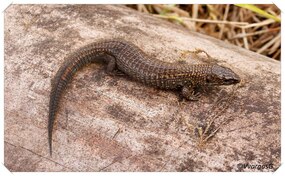
 The last taxonomic contribution of the lab in 2023 is a collaboration with the description of two new species of lizards in the genus Petracola from Peru, led by Luis Mamani. The two new species are Petracola amazonensis and P. shrugojalcapi (shown in the picture by V. Vargas). The two new species increase the diversity of Petracola to seven species. However, like other genera of gymnophthalmids, the diversity is still underestimated. Citation: Mamani, L. , V. J. Vargas, J.C. Chaparo, A. Catenazzi. Two new species of gymnophthalmid lizards (Squamata: Cercosaurinae) from the Andes of Peru and their phylogenetic relationships. Amphibian and Reptile Conservation 17(1-2): : 161–173 (e328).
0 Comments
Lab collaborator Valia Herrera-Alva published today the description of a new species of terrestrial-breeding frog, Pristimantis similaris from the montane forests of southern Peru. The species is cryptic (hence the name) with P. rhabdolaemus and P. pharangobates, also distributed in southern Peru, but molecular analyses and careful examination of their external morphology allowed Valia to set them apart. Pristimantis similaris is a member of the family Strabomantidae, a group of small, ground-dwelling frogs found throughout the tropical Americas. The new species is distinguished by its small size (less than an inch in length), rough skin, and long, slender legs. It also has a distinctive oval-shaped tongue, which it uses to snatch insects from the leaf litter. The discovery of Pristimantis similaris highlights the incredible biodiversity of the Peruvian cloud forests, a hotspot for amphibian endemism. These fragile ecosystems are home to hundreds of frog species, many of which are found nowhere else on Earth. "The cloud forests of Peru are a treasure trove of undiscovered life," said Valia. "This new frog is a reminder that there is still so much we don't know about the natural world, and that even the most common-looking creatures can hold hidden secrets." The scientists who discovered Pristimantis similaris are calling for increased conservation efforts in the Peruvian cloud forests. These irreplaceable ecosystems are threatened by deforestation, climate change, and other human activities. "We need to do more to protect these cloud forests," said Valia. "They are not only home to a wealth of biodiversity, but they also play an important role in regulating the climate and providing clean water. By protecting the cloud forests, we are protecting the future of our planet." The discovery of Pristimantis similaris is a testament to the power of scientific curiosity and the importance of protecting our planet's biodiversity. With continued research and conservation efforts, we can ensure that these remarkable creatures continue to thrive for generations to come. Citation: Herrera-Alva, V., A. Catenazzi, C. Aguilar-Puntriano. 2023. A new cryptic species of terrestrial breeding frog of the Pristimantis danae Group (Anura, Strabomantidae) from montane forests in Ayacucho, Peru. ZooKeys 1187: 1-29.
doi: 10.3897/zookeys.1187.104536  Alessandro was host to Emanuele Biggi's live TV show Geo, and spoke about amphibian declines, their ecological consequences, and the paradox of species discoveries (and rediscoveries) as many more are lost due to habitad destruction, disease, and climate change. The interview (in italian) can be seen online at https://www.raiplay.it/programmi/geo. |
Archives
June 2024
CATENAZZI LABNews from the lab Categories |

 RSS Feed
RSS Feed